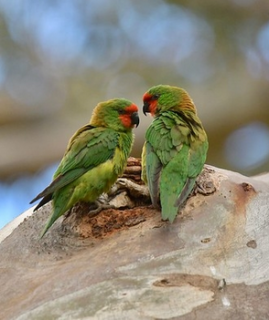Little Lorikeet |
|
|
Also known as: Little Lory, Red-faced Lorikeet, Red-faced Lory, Little Keet, Green Keet, Green Parakeet, Green Leek, Jerryang, Gizzie, Slit
Photos
View in GalleryDid You Know?
The flight of the Little Lorikeet is quick and direct, its short tail pointed straight out, giving the bird a "bullet" like appearance. Its rapid wingbeats produce a whirring sound, much like a hummingbird.Academic Research
Related publications: Glossopsitta pusillaSpecies Profile
Genus: Glossopsitta | Species: pusilla
Size:
15cm (5.8 in)
Weight:
30-50g (1.05-1.75 oz)
Subspecies including nominate:
one
Colour Adult:
Both adults mainly yellow/green in colour; red face; bronze/brown upper mantle; green underwing coverts. Bill black. Eye yellow.
Colour Juvenile:
Red face duller; upper mantle minimal brown. Bill dark brown. Eye brown.
Call:
Calls are high-pitched and rolling, sounding like the rattling of a chain. Continuous chatter while feeding.
Listen NowVideo Links:
Video 1More Information:
Avibase
Birds in Backyards
NSW Govt Office of Environment and Heritage
Content Sources:
CITES
BirdLife International
Cornell Lab of Ornithology/Birds of the World
A Guide to Parrots of the World, Juniper and Parr, 1998
ML Media Collection Catalogue 82330, Little Lorikeet Glossopsitta pusilla, Loetscher, Fred W., Jr., New South Wales, Australia, Nov. 16 1968, Cornell Lab of Ornithology. Site
Parrots of the World, Forshaw and Cooper, 1977. 2010 edition
Parrots of the World, Forshaw, 2006.
Lexicon of Parrots, Thomas Arndt.
Parrots in Aviculture, Low, 1992.
Photos
View in GalleryDid You Know?
The flight of the Little Lorikeet is quick and direct, its short tail pointed straight out, giving the bird a "bullet" like appearance. Its rapid wingbeats produce a whirring sound, much like a hummingbird.Academic Research
Related publications: Glossopsitta pusillaSpecies Care
Captive Status:
Unknown outside Australia since 1959.
Longevity:
15-20 yrs
Housing:
Aviary with drained, sloping concrete floor, or suspended enclosure over concrete floor.
Diet:
Nectar, a commercial type made for small species or one made from lactose-free baby cereal, honey and malt extract or molasses, mixed with filtered water, made fresh once or twice daily; fruits such as: apple, pear, orange, cactus fruits, pomegranate, kiwi, banana.
Enrichment:
Bathing enjoyed and necessary because of liquid diet. Also provide puzzle/foraging toys, washable non-toxic plastic toys, noise makers, ladders, swings and ropes.
Nest Box Size:
Diagonal box 12" x 6" x 7" (30.5cm x 15.2cm x 17.8cm).
Clutch Size:
3-5
Incubation Time:
20 days
Fledging Age:
6 weeks
Hatch Weight:
Not recorded.
Peak Weight:
Not recorded.
Weaning Weight:
Not recorded.
Specialist Club:
Photos
View in GalleryDid You Know?
The flight of the Little Lorikeet is quick and direct, its short tail pointed straight out, giving the bird a "bullet" like appearance. Its rapid wingbeats produce a whirring sound, much like a hummingbird.Academic Research
Related publications: Glossopsitta pusillaSpecies Wild Status
World Population:
Unknown, stable.
IUCN Red List Status:
Least Concern
CITES Listing:
Appendix II
Threat Summary:
Not globally threatened. Common to abundant in centre of range in S Queensland and New South Wales, becoming somewhat common to uncommon near the edges. Is potentially affected by burning for agriculture, loss of nesting trees and nectar-producing (Eucalyptus) trees.
Range:
E and SE mainland Australia; one confirmed record from Tasmania.
Habitat:
Found up to 1600m (5248 ft) in tall open forests, trees along riverways, woodlands, orchards and parks with trees.
Wild Diet:
Takes pollen, nectar, blossoms of Eucalyptus sideroxylon, E. leucoxylon, Melaleuca and Xanthorrhoea trees, flowers and juice of mistletoe Amyema cambagei and A. gaudichaudi, berries of Loranthus and fruit of Eriobotrya japonica.
Ecology and Behaviour:
Noisy and approachable when in groups feeding. Generally seen in flocks that group together in flowering Eucalypt and other trees. Seen often in the company of Rainbow and Musk Lorikeets. Stays mainly in the tall canopy and is not usually seen singly.
Clutch and Egg Size:
3-5 rounded eggs, 19.5 x 16.5mm (0.7 x 0.6 in).
Breeding Season:
June-January, as early as May. Nest is in hollow limb or tree cavity.
Related Links:
Photos
View in GalleryDid You Know?
The flight of the Little Lorikeet is quick and direct, its short tail pointed straight out, giving the bird a "bullet" like appearance. Its rapid wingbeats produce a whirring sound, much like a hummingbird.Academic Research
Related publications: Glossopsitta pusillaMembers Only Resources
Please log-in now to find more research, resources and tools.
Not a Member?
Find more great information:
Gain exclusive access to 600+ pages of additional research, seminars and podcasts, specialists to ask your toughest questions, and dozens of other fun resources - when you become a WPT member.
Join Today >>

































